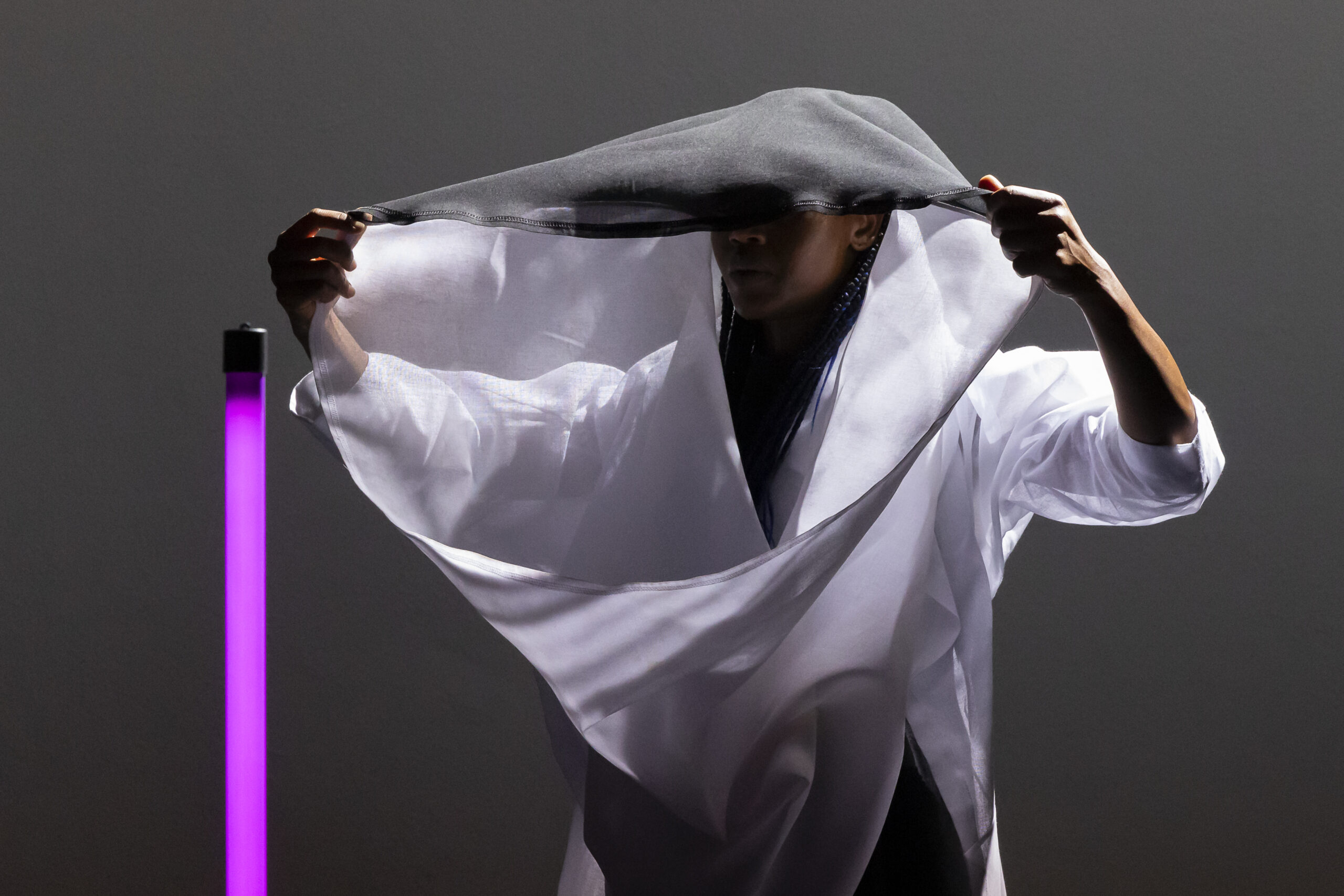to regain the past
amilton de azevedo writes about Toi, moi, Tituba…, by Dorothée Munyaneza (Rwanda + France) presented in the 2025 Festival TransAmériques (FTA – Tiohtià:ké/Montreal). this text is part of a special coverage; the critic traveled to Canada at the invitation of the FTA.
(…) blacklight violates the separation of space / and opens an ethical horizon / with difference but without separability / human and more-than-human / all and at-once / such becomes possible / when phase replaces form / when things move without time / without destination or development / such is possible / when transformation rumbles elemental / leaving ethics stripped of value / and the human / inseparable from all matter. (excerpt from 4 Waters: Deep Implicancy, by Arjuna Neuman and Denise Ferreira da Silva)
Amidst the neon light sticks arranged around the stage, one shines differently; in blacklight. Toi, moi, Tituba… acts seem profoundly entangled with the shifts of the light design (by Marine Le Vey). At first, Dorothée Munyaneza enters the stage as it is a futuristic bright forest, as walking between the barriers of a maze – but Munyaneza’s movements are from one that not only knows but actually open paths; by doing so, she’s opening paths through the knowledge and memories of times.
Then, with the neon lights horizontally on the floor, Munyaneza seems to be glancing at the unknown; discovering it, hearing it, facing and confronting the reality being built onstage. The forest reappears, now showing its shadows and the never-existing silence of nature. Toi, moi, Tituba… presents sort of an arc from opacity towards full transparency.
- Read more: access this link for more theater critics written in english
- Read more: follow ruína acesa’s 2025 FTA special coverage
- Read more: texts written about shows presented in the FTA
Produced by Compagnie Kadidi, the work articulates dance, sound, light and archive: Munyaneza dances and sings, accompanied by a mesmerizing music by her and Khyam Allami that reverberates words within its beats and synths; Le Vey’s designs hide and reveal the performer; and the image of the archive is tied to Munyaneza’s inspiration on Maryse Condé’s I, Tituba, Black Witch of Salem and Elsa Dorlin’s Me, You, Us: “I, Tituba” and the Ontology of the Trace.
In her text, Dorlin states that “through the name Tituba, a thousand scattered traces, a thousand shards of real lives, are brought together, embodied in a biography”. In Toi, moi, Tituba…, these thousand “scattered traces” and “shards of real lives” are embodied in the vivid movements of Munyaneza. Between spasmodic gestures and extactic moments, the performer amalgamates expressivities in such a way that it is difficult to realize where each impulse comes from. As if her body is at the service of those traces and shards, every single centimeter of it with a will of its own – and yet, precise within the wholeness of the compositions; performing a collective oneness.
There is a crescent throughout the work, as Munyaneza creates a choreography made of particles that are re-presented in multiple contexts of the show, ressignified, with more details, a complexer or simpler composition, a different tonus or intention. An open hand that holds, an open hand that gives. A closed hand that grasps, a closed hand that empowers. Her face, her smile, her sweat; all the life that is there to be seen, human or not human. And for what can’t be seen, an attempt to touch the invisible.
While speaking Kinyarwanda, Munyaneza asks – or demands – for names to be remembered. The choice of using her native language adds one more layer on the intricate work: a certain degree of uncapturability. Toi, moi, Tituba… refuses the transparency and chooses what to explain, to make clear, and what not. There is more to see than what is being shown; thus the blacklight: as Denise Ferreira da Silva wrote (in a dialogue about Serpent Rain) “Blacklight, as I have been thinking of it, is about a method, a how. By throwing blacklight at something, one can attend to what is there but is not highlighted: to what is there as a filler, a detail, as means, or a raw material”.
As Allami and Munyaneza are thanking the applauses, their last bow is towards the blacklight, as if in a gesture of recognition of what is in the core of the work: to restitute and honor memories of those who were erased from the archives through colonization and slavery. To guide and to be guided through memories, history, ancestry: Toi, moi, Tituba… is a journey of liberty and communion, not letting aside pain and grief. And as the Yoruba proverbs states that Eshu can throw a rock today and kill a bird yesterday, an artwork performed in the present may be able to restore lifes from the past.


Impressionante como você vai desenhando a performance com palavras…numa língua que não é sua língua materna. Que beleza!